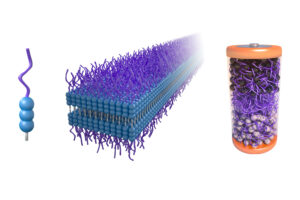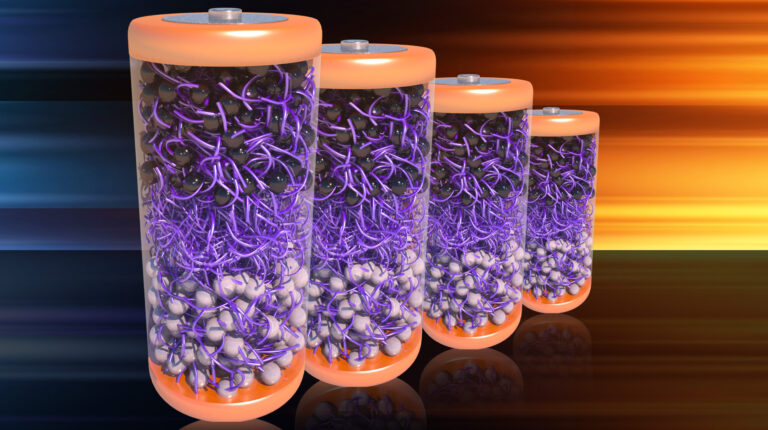Originally published by MIT News
Today’s electric vehicle boom is tomorrow’s mountain of electronic waste. And while myriad efforts are underway to improve battery recycling, many EV batteries still end up in landfills.
A research team from MIT wants to help change that with a new kind of self-assembling battery material that quickly breaks apart when submerged in a simple organic liquid. In a paper published in Nature Chemistry, the researchers showed the material can work as the electrolyte in a functioning, solid-state battery cell and then revert to its original molecular components in minutes.
The approach offers an alternative to shredding the battery into a mixed, hard-to-recycle mass. Instead, because the electrolyte serves as the battery’s connecting layer, when the alternative material returns to its original molecular form, the entire battery disassembles to accelerate the recycling process.
“So far in the battery industry, we’ve focused on high-performing materials and designs, and only later tried to figure out how to recycle batteries made with complex structures and hard-to-recycle materials,” says the paper’s first author, Yukio Cho PhD. “Our approach is to start with easily recyclable materials and figure out how to make them battery-compatible. Designing batteries for recyclability from the beginning is a new approach.”
Joining Cho on the paper are PhD candidate Cole Fincher, Ty Christoff-Tempesta PhD, Kyocera professor of ceramics Yet-Ming Chiang, visiting associate professor Julia Ortony, Xiaobing Zuo and Guillaume Lamour.
Better batteries
There’s a scene in one of the Harry Potter films where Professor Dumbledore cleans a dilapidated home with the flick of the wrist and a spell. Cho says that the image stuck with him as a kid. When he saw a talk by Ortony on engineering molecules so that they could assemble into complex structures and then revert to their original form, he wondered if this technique could be used to make battery recycling work like magic.
That would be a paradigm shift for the battery industry. Today, battery recycling requires harsh chemicals, high heat and complex processing . There are three main parts of a battery: the positively charged cathode, the negatively charged electrode and the electrolyte that shuttles lithium ions between them. The electrolytes in most lithium-ion batteries are highly flammable and degrade over time into toxic byproducts that require specialized handling.

To simplify the recycling process, the researchers decided to make a more sustainable electrolyte. For that, they turned to a class of molecules that self-assemble in water, named aramid amphiphiles (AAs), whose chemical structures and stability mimic that of Kevlar. The researchers further designed the AAs to contain polyethylene glycol (PEG), which can conduct lithium ions, on one end of each molecule. When the molecules are exposed to water, they spontaneously form nanoribbons with ion-conducting PEG surfaces and bases that imitate the robustness of Kevlar through tight hydrogen bonding. The result is a mechanically stable nanoribbon structure that conducts ions across its surface.
“The material is composed of two parts,” Cho explains. “The first part is this flexible chain that gives us a nest, or host, for lithium ions to jump around. The second part is this strong organic material component that is used in the Kevlar, which is a bulletproof material. Those make the whole structure stable.”
When added to water, the nanoribbons self-assemble to form millions of nanoribbons that can be hot-pressed into a solid-state material.
“Within five minutes of being added to water, the solution becomes gel-like, indicating there are so many nanofibers formed in the liquid that they start to entangle each other,” Cho says. “What’s exciting is we can make this material at scale because of the self-assembly behavior.”
The team tested the material’s strength and toughness, finding it could endure the stresses associated with making and running the battery. They also constructed a solid-state battery cell that used lithium iron phosphate for the cathode and lithium titanium oxide as the anode, both common materials in today’s batteries. The nanoribbons moved lithium ions successfully between the electrodes, but a side-effect known as polarization limited the movement of lithium ions into the battery’s electrodes during fast bouts of charging and discharging, hampering its performance compared with today’s gold-standard commercial batteries.
“The lithium ions moved along the nanofiber all right, but getting the lithium ion from the nanofibers to the metal oxide seems to be the most sluggish point of the process,” Cho says.
When they immersed the battery cell in organic solvents, the material immediately dissolved, with each part of the battery falling away for easier recycling. Cho compared the materials’ reaction to cotton candy being submerged in water.
“The electrolyte holds the two battery electrodes together and provides the lithium-ion pathways,” Cho says. “So, when you want to recycle the battery, the entire electrolyte layer can fall off naturally and you can recycle the electrodes separately.”
Validating a new approach
Cho says the material is a proof of concept that demonstrates the recycle-first approach.
“We don’t want to say we solved all the problems with this material,” Cho says. “Our battery performance was not fantastic because we used only this material as the entire electrolyte for the paper, but what we’re picturing is using this material as one layer in the battery electrolyte. It doesn’t have to be the entire electrolyte to kick off the recycling process.”
Cho also sees a lot of room for optimizing the material’s performance with further experiments.
Now, the researchers are exploring ways to integrate these kinds of materials into existing battery designs, and implementing the ideas into new battery chemistries.
“It’s very challenging to convince existing vendors to do something very differently,” Cho says. “But with new battery materials that may come out in five or 10 years, it could be easier to integrate this into new designs in the beginning.”
Cho also believes the approach could help reshore lithium supplies by reusing materials from batteries that are already in the US.
“People are starting to realize how important this is,” Cho says. “If we can start to recycle lithium-ion batteries from battery waste at scale, it’ll have the same effect as opening lithium mines in the US. Also, each battery requires a certain amount of lithium, so extrapolating out the growth of electric vehicles, we need to reuse this material to avoid massive lithium price spikes.”
The work was supported, in part, by the National Science Foundation and the US Department of Energy. It was performed, in part, using the MIT Characterization.nano facilities.


